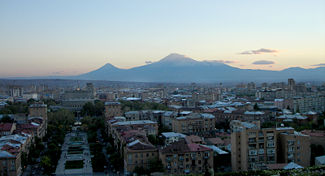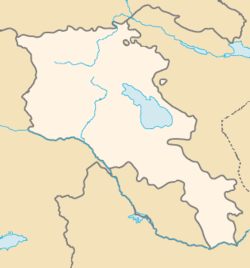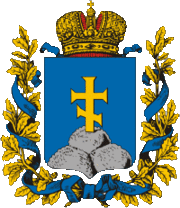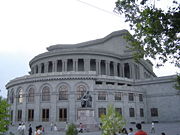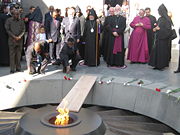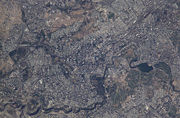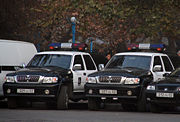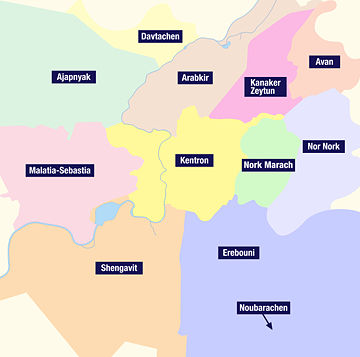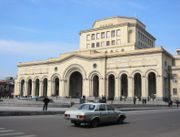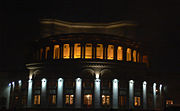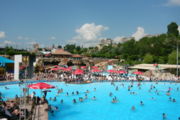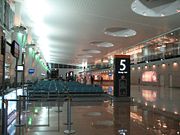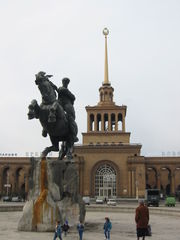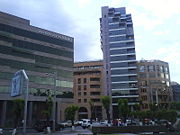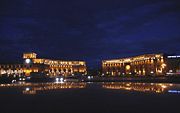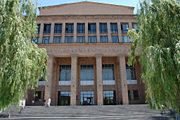Yerevan
2008/9 Schools Wikipedia Selection. Related subjects: Europe; European Cities
Coordinates:
| Yerevan Երեվան |
|||
|
|||
| Location of Yerevan in Armenia | |||
| Coordinates: | |||
|---|---|---|---|
| Country | |||
| Established | 782 BC | ||
| Government | |||
| - Mayor | Yervand Zakharyan | ||
| Area | |||
| - Total | 227 km² (87.6 sq mi) | ||
| Elevation | 989.4 m (3,246 ft) | ||
| Population (2007) | |||
| - Total | 1,107,800 | ||
| - Density | 5,196.4/km² (13,458.6/sq mi) | ||
| Time zone | GMT+4 ( UTC+4) | ||
| - Summer ( DST) | GMT+5 ( UTC+5) | ||
| Website: www.yerevan.am | |||
Yerevan ( Armenian: Երևան or Երեւան), pronounced /ˌjɛrəˈvɑːn/; sometimes written as Erevan, Iravan, Erewan, Ayrivan, and Erivan; former names include Erebuni, Revan, Ereun, and Yervandavan) is the capital and largest city of Armenia. It is situated on the Hrazdan River, and is the administrative, cultural, and industrial centre of the country. It has been the capital of Armenia since 1918 and the twelfth in the history of Armenia.
The history of Yerevan dates back to the 8th century BC, with the founding of the Urartian fortress of Erebuni in 782 BC at the western extremity of the Ararat plain. After World War I, Yerevan became the capital of the Democratic Republic of Armenia as thousands of survivors of the Armenian Genocide settled in the area. The city expanded rapidly during the 20th century when Armenia became one of the fifteen republics in the Soviet Union. In fifty years, Yerevan was transformed from a town of a few thousand residents during the first republic to the principal cultural, artistic and industrial centre as well as becoming the seat of the political institutions of the country.
With the growth of the economy of the country, Yerevan has been undergoing a major transformation as construction sites have appeared all over the city since the early 2000s. Today, the appearance of new buildings, roads, restaurants, boutiques, quarters etc. have started to erase the traces of 70 years of Soviet dominance.
In 2007, the population of Yerevan was estimated to be 1,107,800 people with the agglomeration around the city regrouping 1,245,700 people (official estimation), more than 42% of the population of Armenia.
Etymology and symbols
According to Armenian tradition, the name of Yerevan is derived from an expression exclaimed by Noah in Armenian while looking in the direction of Yerevan, after the ark had landed on Mount Ararat and after the flood waters had receded: "Yerevants!" ("it appeared!"). The more plausible theory on the origin of the name is that the city was named after the Armenian king, Yervand the Third (the Last), the last leader of the Orontid Dynasty and founder of the city of Yervandashat.
An Urartian military fortress called Erebuni (Էրեբունի), founded on the territory of modern-day Yerevan in the 8th century BC, had its name in time transformed into Yerevan; Margarit Israelyan noted these changes when comparing the inscriptions found on two cuneiform tablets:
The transcription of the second cuneiform bu [original emphasis] of the word was very essential in our interpretation as it is the Urartaean b that has been shifted to the Armenian v (b > v). The original writing of the inscription read «er-bu-ni»; therefore the prominent Armenianologist- orientalist Prof. G. A. Ghapantsian justly objected, remarking that the Urartu b changed to v at the beginning of the word (Biani > Van) or between two vowels (ebani > avan, Zabaha > Javakhk)....In other words b was placed between two vowels. The true pronunciation of the fortress-city was apparently Erebuny.
The principal symbol of Yerevan is Mount Ararat of Turkey which is visible from any area in the capital. The seal of the city is symbolized by a crowned lion on a pedestal with the inscription "Yerevan" with the head turned back and holding a scepter with the right front leg, which is the attribute of power and royalty. The symbol of eternity is on the breast of the lion with a picture of the Ararat in its upper part. The emblem has a form of a rectangular shield with the blue border line.
Since September 27, 2004, Yerevan has adopted a hymn, Erebuni-Yerevan, written by Paruyr Sevak and composed by Edgar Hovhanissian. It was selected in a competition for a new hymn and flag that would best represent the city. The chosen flag has a white background with the seal in the middle surrounded by twelve small red triangles that symbolize the twelve historic capitals of Armenia. The flag shows the three colours of the Armenian National flag on itself. The lion is on the orange background with blue edging.
History
Early history
The territory of Yerevan was settled in the fourth millennium BC, fortified settlements from the Bronze Age include Shengavit, Tsitsernakaberd, Karmir Blur, Arin Berd, Karmir Berd and Berdadzor. Archaeological evidence, such as a cuneiform inscription, indicates that an Urartian military fortress called Erebuni (Էրեբունի) was founded in 782 BC by the orders of King Argishti I at the site of current-day Yerevan, to serve as a fort and citadel guarding against attacks from the north Caucasus. Yerevan is thus one of the most ancient cities in the world.
Between the sixth and fourth centuries BC, Yerevan was one of the main centers of the Armenian satrapy of the Achaemenid Empire. During the height of Urartian power, irrigation canals and an artificial reservoir were built on Yerevan's territory. In 585 BC, the fortress of Teishebaini (Karmir Blur), thirty miles to the north of Yerevan, was destroyed by an alliance of Medes and the Scythians.
Due to the absence of historical data, the timespan between fourth century BC and third century AD is known as the "Yerevan Dark Ages." The first church in Yerevan, the church of St. Peter and Paul, was built in the fifth century (it was demolished in 1931 and a cinema built on its site).
Foreign (Persian and Ottoman) rule
In 658 AD, Yerevan was conquered, during the height of Arab invasions. Since then the site has been strategically important as a crossroads for the caravan routes passing between Europe and India. It has been known as "Yerevan" since at least the seventh century AD. Between the ninth and eleventh centuries, Yerevan was a secure part of the Armenian Bagratuni Kingdom, before being overrun by Seljuks. The city was seized and pillaged by Tamerlane in 1387 and subsequently became an administrative centre of the Ilkhanate. Due to its strategic significance, Yerevan was constantly fought over and passed back and forth between the dominion of Persia and the Ottomans.
At the height of the Turkish-Persian wars, the city changed hands fourteen times between 1513 and 1737. In 1604, under the order of Shah Abbas I, tens of thousands of Armenians (including citizens of Yerevan) were deported to Persia. As a consequence, Erivan khanate population became 80 percent Muslim (Persians, Turco, Kurds) and 20 percent Armenian. Muslims were either sedentary, semi-sedentary, or nomadic. Armenians lived in Erevan or the villages. The Armenians dominated the various professions and trade in the area and were of great economic significance to the Persian administration. The Ottomans, Safavids and Ilkhanids all maintained a mint in Yerevan. During the 1670s, the Frenchman Jean Chardin visited Yerevan and gave a description of the city in his Travels of Cavalier Chardin in Transcaucasia in 1672-1673. On June 7, 1679, a devastating earthquake razed the city to the ground. During the Safavid Dynasty rule, Yerevan and adjacent territories were part of the Chukhursaad (Irevan) Beglerbekate. Starting from 1747, it was part of the Erivan khanate, a Muslim principality under the dominion of the Persian Empire. This lasted until 1828 when the region was incorporated into Russian Empire.
Foreign (Russian) rule
During the second Russian-Persian war, Yerevan was captured by Russian troops under general Ivan Paskevich on 1 October, 1827. It was formally ceded by the Persians in 1828, following the Treaty of Turkmenchay. Tsarist Russia sponsored Armenian resettlement from Persia and Turkey; by the turn of the twentieth century, Yerevan's population was over 29,000, of which 49% were Muslim (mostly Kurds and Azeris, then referred to as Tatars), 48% Christian Armenian and 2% Russian. It served as the seat of the newly-formed Armenian Oblast and subsequently the Erivan Governorate.
The city began to grow economically and politically, with old buildings torn down and new buildings in European style erected in their place. In 1829, Armenian repatriates from Persia were resettled in the city and a new quarter was built. By the time of Nicholas I's visit in 1837, Yerevan had become a uyezd.
The first general plan of the city was made in 1854, during which time the women's colleges of St. Hripsime and St. Gayane were opened and the English Garden built. In 1874, Zacharia Gevorkian opened Yerevan's first printing house and in 1879 the first theatre, sited near the church of St. Peter and Paul, was established. Two years into the twentieth century, a railway line linked Yerevan with Alexandropol, Tiflis and Julfa, the same year Yerevan's first public library opened. In 1913, a telephone line with eighty subscribers became operational. The early twentieth century saw the governorship of Erivan province by Louis Joseph Jérôme Napoléon (1864-1932), grandnephew of Napoleon I.
Brief independence (1917–1920)
At the start of the 20th century, Yerevan was a small town with a population of 30,000. In 1917, the Russian Empire ended with the October Revolution. In the aftermath, Armenian, Georgian and Muslim leaders of Transcaucasia united to form the Transcaucasian Federation and proclaimed Transcaucasia's secession.
The Federation, however, was short-lived and on May 28, 1918, Yerevan became the capital of the newly-independent Democratic Republic of Armenia and therefore became the centre of independent Armenia. On November 29, 1920, the Bolshevik 11th Red Army occupied Yerevan during the Russian Civil War. Although nationalist forces managed to retake the city in February 1921, the city once again fell to Soviet forces on April 2, 1921.
Soviet Yerevan
Yerevan became the capital of the newly formed Armenian Soviet Socialist Republic, one of the fifteen republics of the Soviet Union. The Soviet era transformed the city into a modern industrial metropolis of over a million people, developed according to the prominent Armenian architect Alexander Tamanian's designs. Yerevan also became a significant scientific and cultural centre.
Tamanian incorporated national traditions with contemporary urban construction. His design presented a radial-circular arrangement that overlaid the existing city. As a result, many historic buildings were demolished, including churches, mosques, the Persian fortress, baths, bazaars and caravanserais. Many of the surrounding districts around Yerevan were named after former Armenian communities that were decimated by the Ottoman Turks during the Armenian Genocide. The districts of Arabkir, Malatya-Sebastia and Nork Marash, for example, were named after the towns Arabkir, Malatya, Sebastia, and Marash, respectively. Following the end of the Second World War, German POWs were used to help in the construction of new buildings and structures, such as the Kievyan Bridge.
In 1965, during the commemoration of the fiftieth anniversary of the Armenian Genocide, Yerevan was the centre of a 24-hour mass anti-Soviet protest, the first such demonstration in the Soviet Union, to demand recognition of the Genocide by the Soviet authorities. In 1968, the city's 2,750th anniversary was commemorated.
Yerevan played a key role in the Armenian national democratic movement that emerged during the Gorbachev era of the 1980s. The reforms of Glasnost and Perestroika opened questions on issues such as the status of Nagorno-Karabakh, the environment, Russification, corruption, democracy, and eventually independence. At the beginning of 1988, nearly one million Yerevantsis engaged in demonstrations concerning these subjects, centered on Theatre Square.
Post-USSR independence
Following the end of the Soviet Union, Yerevan became the capital of the Republic of Armenia on September 21, 1991. Maintaining supplies of gas and electricity proved difficult; constant electricity was not restored until 1996. Also in the last five years, central Yerevan has been transformed into a vast construction site, with cranes seemingly outnumbering trees. Officially, the scores of multi-storied buildings are part of large-scale urban planning projects. Roughly $1.8 billion was spent on such construction in 2006, according to the national statistical service. Prices for downtown apartments have increased by about ten times over the last decade, realtors say. However, some experts have voiced their opinions, and have asserted that many of the new edifices violate urban planning and earthquake safety requirements.
Political demonstrations still occur in Yerevan, usually as a result of disputed election results. Recently, unrest in the capital between the authorities and opposition demonstrators led by ex-President Levon Ter-Petrossian occurred after the 2008 Armenian presidential election. The events resulted in ten deaths and a subsequent 20-day state of emergency declared by President Robert Kocharian.
Geography
Topography and Location
- Altitude: average 990 m - minimum 865 m - maximum 1,390 m.
- Location: to the edge of the Hrazdan river, north-east of the Ararat plain.
Yerevan is located in Eastern Armenia to the centre-west of the country in the north-eastern extremity of the Ararat Valley. The upper part of the city is surrounded by mountains on three sides while to the south it descends to the banks of the river Hrazdan, a tributary of the river Arax. The Hrazdan divides Yerevan in two within a picturesque canyon. The city's elevation ranges between 900 to 1,300 m (3,000 to 4,300 ft) above sea level.
As the capital of Armenia, Yerevan is not part of any marz ("province"). Instead, it borders the following marzer: Kotayk (north), Ararat (south), Armavir (southwest) and Aragatsotn (northwest).
Climate
| Climate chart for Yerevan | |||||||||||
|---|---|---|---|---|---|---|---|---|---|---|---|
| J | F | M | A | M | J | J | A | S | O | N | D |
|
29
-2
-9
|
25
1
-8
|
28
10
-1
|
48
19
6
|
53
24
10
|
23
31
14
|
15
34
17
|
8
33
18
|
13
28
13
|
23
21
7
|
31
10
1
|
28
3
-3
|
| temperatures in °C precipitation totals in mm source: BBC Weather |
|||||||||||
|
Imperial conversion
|
|||||||||||
The climate of Yerevan is relatively continental, with dry, hot summers and cold and short winters. This is attributed to the fact that Yerevan is located on a plain surrounded by mountains and to its distance to the sea and its effects. The summers are usually very hot with the temperature in August reaching up to 40 ° C (104 ° F), while winters generally carry snowfall and freezing temperates with January being often as cold as -15 °C (5 °F). The amount of precipitation is small, amounting annually to about 350 mm (14 in). The city has an annual period of sunshine of approximately 2,700 hours.
Government and politics
Capital
Yerevan has been the capital of Armenia since the independence of the First Republic in 1918. Situated in the Ararat plain, the historic lands of Armenia, it served as the best logical choice for capital of the young republic at the time.
When Armenia became a republic of the Soviet Union, Yerevan remained as capital and accommodated all the political institution of the republic. In 1991 with the independence of the Third Armenian republic, Yerevan remained the political centre of the country and became the location of all the national institution: the Azgayin Zhoghov, ministries, the presidential palace, public organisms and judicial institutions.
Municipalities
The Armenian Constitution, adopted on July 5, 1995, granted Yerevan the status of a marz (region). Therefore, Yerevan functions similarly to the other regions of the country with a few specificities.
The administrative authority of Yerevan is thus represented by:
- the mayor, appointed by the President (who can remove him at any moment) upon the recommendation of the Prime Minister, alongside a group of four deputy mayors heading eleven ministries (of which financial, transport, urban development etc.),
- the Yerevan Council, regrouping the Chiefs of neighbourhood communities under the authority of the mayor,
- twelve neighbourhood communities (or twelve districts), with each having its own chief and their elected councils. Yerevan has a principal city hall and twelve deputy mayors of districts.
The last modification to the Constitution on November 27, 2005 turned the city into a "community"; since, the Constitution declares that this community has to be led by a mayor, elected directly or indirectly, and that the city needs to be governed by a specific law. This law is currently in preparation in the Armenian parliament that adopted its first draft in December 2007 and should do the same in the second draft in spring of 2008. The project on the law envisions an indirect election of the mayor.
Artashes Geghamyan was the last mayor of the Armenian SSR and Hambartsoum Galstyan, the first mayor of the Third Republic. Since 1991, there have been eight mayors of Yerevan. The current mayor is Yervand Zakharyan. In addition to the national police and road police, Yerevan has its own municipal police. All three bodies maintain law in the city by cooperating.
Districts
Yerevan is divided into twelve districts (Համայնք), each with an elected community leader. Each district is divided into neighborhoods (Թաղամաս). A district can have up to seven neighborhoods.
| Districts (Համայնք) |
Population | Area | Neighbourhood (Թաղամաս) |
|---|---|---|---|
| Ajapnyak Աջափնյակ |
|
|
Ajapnyak, Norashen, Nazarbekian, Silikian, Lukashin, Haghtanak, Vahakni |
| Arabkir Արաբկիր |
|
|
Nor Arabkir, Aygedzor |
| Avan Ավան |
|
|
Avan, Avan Aresh 1 and 2 |
| Davtashen Դավթաշեն |
|
|
Davtashen, Narek |
| Erebuni Էրեբունի |
|
|
Erebuni, Nor Aresh, Sari Tagh, Vardashen, Mushavan, Verin Jrashen |
| Kanaker-Zeytun Քանաքեր-Զեյթուն |
|
|
Kanaker, Nor Zeytun |
| Kentron Կենտրոն |
|
|
Pokr Kentron, Noragyugh, Nor Kilikia, Aygestan, Tigran mez Kond |
| Malatia-Sebastia Մալաթիա-Սեբաստիա |
|
|
Nor Malatia, Nor Sebastia, Zoravar Andranik, Shahumian, Araratian |
| Nork-Marash Նորք-Մարաշ |
|
|
Nork, Nor Marash |
| Nor Nork Նոր Նորք |
|
|
Nor Nork |
| Nubarashen Նուբարաշեն |
|
|
Nubarashen |
| Shengavit Շենգավիթ |
|
|
Nerkin Shengavit, Verin Shengavit, Koghb, Nerkin Charbakh, Verin Charbakh, Noragavit |
Demographics
Originally a small town, Yerevan became the capital of Armenia and a large city with over one million inhabitants.
Until the fall of the Soviet Union, the majority of the population of Yerevan were Armenians with minorities of Russians, Kurds, Azeris and Iranians present as well. However with the breakout of the Nagorno-Karabakh War from 1988 to 1994, the Azeri minority diminished in the country in what was part of population exchanges between Armenia and Azerbaijan. A big part of the Russian minority also fled the country during the 1990s economic crisis in the country. Today, the population of Yerevan is mainly Armenian.
Like the rest of the country and all other ex-Soviet republics, a lot of people fled their countries (mostly to Europe and North America) due to economic crises. The population of Yerevan fell from 1,250,000 in 1989 to 1,103,488 in 2001 and to 1,091,235 in 2003. However, the population of Yerevan has been increasing since. In 2007, the capital had 1,107,800 inhabitants.

| 1827 | 1890 | 1917 | 1926 | 1939 | 1970 | 1975 | 1979 | 1989 | 1998 | 2003 | 2006 |
|---|---|---|---|---|---|---|---|---|---|---|---|
| 10 000 | 12 500 | 34 000 | 65 000 | 204 000 | 767 000 | 899 000 | 1 019 000 | 1 201 539 | 1 249 202 | 1 091 235 | 1 104 900 |
Sources : Municipality of Yerevan, ArmStat
- Growth rate of the population : 0,29 % (in 2006).
- Birth rate : 1,12 % (en 2006).
- Death rate : 0,83 % (en 2006).
- Rate of infantile mortality : 1,05 % (en 2006).
Culture
Museums and Libraries
Yerevan's principal museum is the National Gallery of Armenia that was constructed in 1921. It is integrated to the Armenia's History Museum. In addition to having a permanent exposition of works of painters such as Aivazovsky, Kandinsky, Chagall, Theodore Rousseau, Monticelli or Eugene Boudin, it usually hosts temporary expositions such as Yann Arthus-Bertrand in 2005 or the one organized on the occasion of the Year of Armenia in France in October 2006.
The Armenian Genocide museum is found at the foot of Tsitsernakapert and features numerous eyewitness accounts, texts and photographs from the time. The Matenadaran is a library-museum regrouping 17 000 ancient manuscripts and several bibles from the Middle Ages. Its archives hold a rich collection of valuable ancient Armenian, Greek, Assyrian, Hebrew, Roman and Persian manuscripts. It is located in the centre of the city on Mesrop Mashdots avenue.
Next to the Hrazdan river, the Parajanov museum that was completely renovated in 2002, has 250 works, documents and photos of the Armenian filmmaker and painter. Yerevan has several other museums like the museum of the Middle-East and the Museum of Yerevan.
Cinemas, Theatres, Opera and Concert Halls
The city of Yerevan possesses several cinema halls among them the famous Moskva cinema. Most of the world's hit movies are available to watch at the same time of their release elsewhere. Some of the movies that are shown in the cinemas are Russian.
Since 2004, Moskva hosts each year the Golden Apricot international film festival. The last edition of the festival presided by Atom Egoyan was held from July 9 to July 14 2007 with the Golden Apricot going to the film Import/Export from Austrian filmmaker Ulrich Seidl.
The Opera Theatre of Yerevan hosts the Aram Khatchaturian concert hall, the national theatre of opera and the Alexander Spendiarian ballet. The numerous theatres have permitted attendance to a multitude of various pieces and the some spectacle rooms, of which the big one Hamalir, sometimes offer some concerts even if the temperate Armenian summers allow the organization of the bulk of the concerts to be held outside.
Amusement Parks and Zoo
The Yerevan Zoo was founded in 1940. After a period of difficulty during the 1990s, the zoo is in better economic shape today. The zoo hosts elephants, eagles, bears, camels and 260 other animal species.
Waterworld is a water park in Yerevan. It has several pools, toboggans, bars and restaurants. The park used to close from October to May but construction of an indoors section called Aquatek has permitted the water park to be open all year. The indoors section has jacuzzis, pools, hammams, fitness rooms, restaurants and a hotel.
On the road to Lake Sevan, there is an amusement parc called Play City that has a bowling arena, a cinema, paint-ball, karting and video-game rooms.
Tourism
Tourism in Armenia has been developping every year and the capital city of Yerevan is one of the major tourist destinations. The city has the majority of hotels, restaurants, bars and nightclubs in the country. Zvartnots airport has also conducted renovation projects with the growing number of tourists visiting the country. Two major tourist attractions are the Opera House, the ruins of an Urartu fortress and a Roman fortress. The Armenia Marriott Hotel is situated in the heart of the city at Republic Square (also known as Hraparak).
Transportation
Air
Yerevan is served by the Zvartnots International Airport, located 12 km west of the city centre. It is the primary airport of the country and the hub of Armavia. Inaugurated in 1961 during the Soviet era, Zvartnots airport was renovated for the first time in 1985 and a second time in 2002 in order to adapt to international norms. It went through a facelift starting in 2004 with the construction of a new terminal. The first phase of the construction ended in September 2006 with the opening of the arrivals zone. A second section designated for departures was inaugurated in May 2007. The entire project cost more than $100 million USD.
The airport has flights to dozens of countries which include France, Russia, Germany, United Kingdom, Austria, Netherlands, Czech Republic, Ukraine, Israel, Lebanon, Turkey etc.
A second airport, Erebuni Airport, is located just south of the city. Since independence of the country in 1991, the airport is mainly used by the military or for private flights. The Armenian Air Force has equally installed its base there and there are several MiG-29s stationed on Erebuni's tarmac.
Bus and Tramway
Yerevan has 46 bus lines and 24 trolleybus lines. The trolleybuses have been operating in the streets of Yerevan since 1949. Old Soviet-era buses are slowly being replaced by new buses. Outside the bus lines that cover the city, some buses at the start of the central road train station located in the Nor Kilikia neighbourhood serve practically all the cities of Armenia as well as of others abroad, notably Tbilisi in Georgia or Tabriz in Iran.
The tramway network that operated in Yerevan since 1906 was decommissioned in January 2004. Its use had a cost 2.4 times higher than the generated profits which pushed the municipality to shutdown the network, despite a last ditch effort to save it towards the end of 2003. Since the closure, the rails have been dismantled and sold.
Metro
The Yerevan Metro (Երեւանի մետրոպոլիտեն) is a rapid transit system that serves the capital city. It has one 13.4km (8.37 miles) line and currently services 10 active stations. Its interior resembles that of western former Soviet nations with chandeliers hanging from the corridors. The metro stations had most of their names changed after the collapse of the Soviet Union and the Independence of the Republic of Armenia.
A northeastern extension of the line with two new stations is currently being planned. The construction of the first station (Ajapnyak) and of the one kilometer tunnel linking it to the rest of the network will cost 18 million USD. The time of the end of the project has not yet been defined. Another long term project is the construction of two new lines but these have been suspended due to a deficit in the bugdet balance.
Train
Yerevan has a single central train station (several train stations of suburbs have been not been used since 1990) that is connected to the metro via the Sasuntsi Davit station. The train station is made in Soviet-style architecture with its long point on the building roof, representing the symbols of communism: red star, hammer and sickle. Due to the Turkish and Azerbaijani blockades of Armenia, there are only about four regional trains per day and one international train that passes by once every two days with neighboring Georgia being its destination. For example, for a sum of 9 000 to 18 000 dram, it is possible to take the night train to the Georgian capital, Tbilisi. This train the continues to its destination of Batumi, on the shores of the Black sea.
The only railway that goes to Iran to the south passes by the closed border of Nakhichevan. For this reason, there are no trains that go south from Yerevan. A construction project on a new railway line connecting Armenia and Iran directly is currently being studied.
Economy
Industry
In 2001, Yerevan's share of national industrial production was approximately 50%.. Yerevan's manufactures include chemicals, primary metals, machinery, rubber products, plastics, textiles, and processed food. Even though the economic crisis of the 90s ravaged the industry of the country, several factories remain always in service, notably in the petrochemical and the aluminium sectors. Not only is Yerevan the headquarters of major Armenian companies, but of international ones as well, as it's seen as an attractive outsourcing location for Western European, Russian and American multinationals. Yerevan is also the country's financial hub, home to the Armenian National Bank, the Armenian Stock Exchange, as well as some of the country's largest commercial banks.
Yerevan's location on the shores of Hrazdan river has enabled the production of hydroelectricity. Two plants are established on the territory of the municipality. There is also a thermal central station, situated to the city's south, that furnishes equally a little electricity.
Construction
The construction sector has experienced strong growth since 2000. Recently, Yerevan has been undergoing an extensive and controversial redevelopment process in which Czarist and Soviet-period buildings have been demolished and replaced with new buildings. This urban renewal plan has been met with opposition and criticism from some residents. Coupled with the construction sector's growth has been the increase in real estate prices. Downtown houses deemed too small are more and more demolished and replaced by high-rise buildings. Jermaine Jackson has planned to build an entertainment complex in a new 5-star hotel which is being built in the city.
Monuments, movie theaters and other buildings
| Cascades | Massive white steps that ascend from downtown Yerevan towards Haghtanak Park (Victory Park). |
| Cossack Monument | A monument to the Cossacks killed during the Russian-Persian wars in 1826-1827. |
| Hamalir | Concert hall and sports complex. |
| Matenadaran | Institute of Ancient Manuscripts. One of the richest depositories of manuscripts and books in the world. |
| Moscow Cinema (Kino Moskva) | Famous movie theatre. |
| Mother Armenia | A statue located in Haghtanak Park (Victory Park). |
| Nairi Cinema (Kino Nairi) | Famous movie theatre. |
| Pantheon Cemetery | Cemetery where many famous Armenians are buried. |
| Sasuntsi Davit | A statue dedicated to a famous Armenian hero. |
| Statue of Hayk | Statue of a legendary patriarch and founder of the Armenian nation. |
| Tsitsernakaberd | Monument commemorating the victims of the Armenian Genocide. |
| Yerablur | Cemetery where Armenians that fought in the Nagorno-Karabakh War are buried. |
| Yerevan Zoo | Yerevan zoo. |
Sister cities
Currently, Yerevan has twenty-six sister cities.
| City | Country | Year |
|---|---|---|
| Carrara | From 1965 | |
| Podgorica | From 1974 | |
| Antananarivo | From 1981 | |
| Cambridge, MA | From 1987 | |
| Marseille | From 1992 | |
| Athens | From 1993 | |
| Lyon | From 1993 | |
| Stavropol | From 1994 | |
| Ispahan | From 1995 | |
| Kiev | From 1995 | |
| Moscow | From 1995 | |
| Odessa | From 1995 | |
| Florence | From 1996 | |
| Tbilisi | From 1996 | |
| Beirut | From 1997 | |
| Damascus | From 1997 | |
| Saint-Petersburg | From 1997 | |
| Montreal | From 1998 | |
| Paris | From 1998 | |
| Volgograd | From 1998 | |
| Bratislava | From 2001 | |
| Minsk | From 2002 | |
| São Paulo | From 2002 | |
| Chisinau | From 2005 | |
| Rostov-on-Don | From 2005 | |
| Los Angeles | From 2007 |
Education
As the capital of Armenia, Yerevan has the biggest number of educational institutions in the country. There are 27 colleges and twelve art schools that are administered by the Minister of Education of Armenia.
The biggest public and private universities of Armenia are located in Yerevan. They attract large numbers of foreign students, notably from India, because of competitive prices and education of health science in English.
Universities
Universities in Yerevan include:
| Institute | Official website | Date established |
Student population |
|
|---|---|---|---|---|
| American University of Armenia | AUA | http://www.aua.am | 1991 | 268 |
| Eurasia International University | EIU | http://eurasiaiu.com/en/eiu | 1996 | 550 |
| State Engineering University of Armenia | SEUA | http://www.seua.am | 1933 | 10,000 |
| Yerevan State University | YSU | http://www.ysu.am | May 16, 1919 | 10,450 |
| Yerevan State Linguistic University | YSLU | http://www.brusov.am | February 4, 1935 | |
| Yerevan State Medical University | YSMU | http://www.ysmu.am | 1930 | |
| Yerevan State Musical Conservatory | YSC | http://www.conservatory.am | 1921 | |
| Yerevan State Pedagogical University | YSPU | 1922 | ||
| Russian-Armenian State University | RAU | http://www.rau.am | August 29, 1997 | 1,600 |
Sports
The most played and popular sport in Yerevan is football. Yerevan has many clubs with six in the 2008 season of the top league.
| Club | Stadium |
|---|---|
| Ararat Yerevan | Hrazdan Stadium |
| Banants Yerevan | Banants Stadium |
| Kilikia Yerevan | Hrazdan Stadium |
| Ulisses Yerevan | Kasakhi Marzik Stadium |
| Mika Yerevan | Mika Stadium |
| Pyunik Yerevan | Republican Stadium |
| Yerevan United | |
| Dinamo Yerevan | |
| Erebuni Yerevan | |
| Kanaz Yerevan | |
| Lernayin Artsakh | |
| Malatia Yerevan | |
| Nairit Yerevan | |
| Van Yerevan | |
| Yerazank Yerevan | |
| FC Yerevan |
Yerevan has five major stadiums which are Nairi Stadium, Banants Stadium, Mika Stadium, Republican Stadium and Hrazdan Stadium. Hrazdan is the main and biggest stadium which also houses a sports complex that is composed of boxing and karate training facilities and basket-ball and tennis courts.
Armenia has always excelled in chess with its players being very often among the highest ranked and decorated. The headquarters of the Armenian Chess Federation is located in the Kentron (central district) in Yerevan and there exists plenty of chess clubs in the city. In 1996, despite a severe economic crisis, Yerevan hosted the 32nd Chess Olympiad. In 2006, the four members from Yerevan of the Armenian chess team won the world championships in Turin. The Yerevan-born leader of this team, Levon Aronian, is currently one of the world's top chess players and is number six on the April 2008 FIDE rankings.
Notable people
Notable people who are from or have resided in Yerevan:
|
|
List of notable persons born in Yerevan: People from Yerevan
Cityscape
